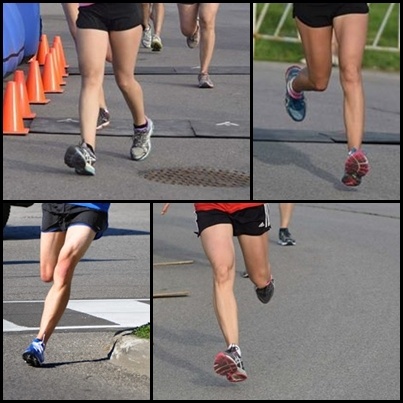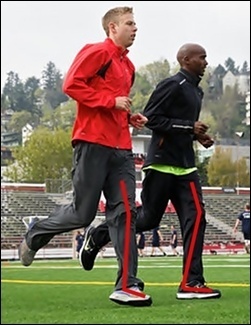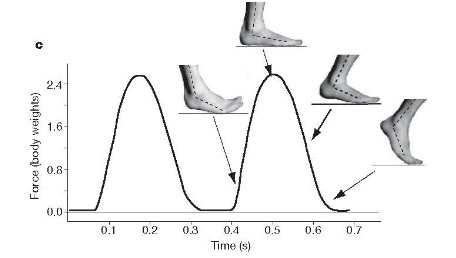Heel strike running is the slowest form of running whereas forefoot running is the fastest, which is why sprinters use a forefoot strike as well as world record holders in the 5,000m to the marathon, are forefoot runners.

This doesn’t mean that a heel strike runner can’t break a world record, because they do. There are exceptions where a heel strike runner breaks a world record, but the exception doesn’t un-prove the rule, it proves the rule because it takes an average of at least 12 years for a heel strike runner to break a world record. It takes a forefoot runner an average of 4 years to break a world record. Therefore, forefoot runners break more world records by a significantly larger multiple than heel strike runners. So, what is it about heel strike running that makes it slower than forefoot running?
2 Reasons Heel Strike Running is Slower than Forefoot Running
In running, foot strike pattern directly affects the flow of impact and elastic energy storage whereby the more elastic energy stored in the arch and Achilles tendon, the more efficient you’ll run because you’ll use less costly muscle effort.
There are two factors that cause heel striking when running to slow your advances in your performance, and keeps you injured: 1. extensive muscular effort and 2 unusually long ground-contact time.
#1. Extensive Muscular Effort
In heel strike running, greater muscular effort is used to take larger strides in opposition to gravity. As it turns out, landing farther back on your heel causes the knee-joint to completely unbend and extend. This also causes the foot to land too far ahead of the hips, while also pushing the upper body slightly backwards, farther behind initial foot-strike position, shown below:

A study in the Journal of Applied Physiology provided evidence for this such that taking longer strides requires significantly more muscular effort to elevate the body’s mass for the ensuing step, resulting in pre-mature physical fatigue. Another way taking longer strides doesn’t pay off for running economy is by making the Achilles tendon and the arch of the foot less efficient at storing and releasing energy-saving elastic power.
A study in the Journal of Biomechanics revealed no mechanical advantage to taking elongated steps because it disrupts the natural spring properties of the leg and foot. It also increases braking which slows the forward movement of the center of mass. It’s like running with the brakes on.
In contrast, related studies found forefoot running enables the Achilles and the arch to store more elastic energy at lower costs, thereby substantially reducing the amount of muscle energy to thrust the body forward.

#2. Too Long Ground-Contact Time
Another big factor that slows heel strike runners down is the foot spends more time on the ground and eventually is pushed out of its neutral range and into extreme positions. This is known as foot over-pronation and it also causes injury because it transfers too much bending and twisting strain up the leg.


Another way longer ground-contact time slows a runner down is that it was found to impair the stretch-shortening cycle of the Achilles tendon, therefore limiting elasticity effectiveness as well as increasing energy costs. Therefore, a heel strike landing when running counters the economical benefits of the Achilles tendon by making inefficient use of the foot.
Forefoot Running Has the Opposite, And BEST Effect!
Forefoot running literally has the opposite effect, in the most positive ways, on the foot, arch and Achilles tendon by naturally shortening stride length and reducing ground-contact time.


Forefoot running reduces stride length by naturally preventing over-reaching of the foot upon landing, and instead, naturally flexes (bends) the knee which positions the foot closer to the hips (shown above). In this way, you’re in a better place to leverage a much faster turnover that’s easily sustainable. Also, a shorter stride length and less ground-contact time naturally go hand-in-hand!
Better yet, in forefoot running, the movement path of the foot during stance is the complete reverse to heel striking such that the foot travels forefoot-to-heel, which ends up being a much shorter line of travel of the foot with the ground, shown below:

Because it improves the natural abilities of the arch and Achilles to store more energy-saving elastic power, the forefoot-to-heel movement path of the foot uses these structures the way they were designed. It’s only really functional if it’s used the way it was intended, and only in forefoot running will the arch and Achilles act as effectual springs for more efficient accelerations.

The Take Home Message
Landing with a forefoot strike when running is the most functional and efficient way to use your feet because it naturally puts in motion the mechanics that enables more involvement of elastic strain energy to draw from the Arch and Achilles, while keeping your stride within a short range and softening your step – All the more reason to make the switch from heel strike to forefoot strike sooner than later!
Read more here about all the evidence-based reasons forefoot running is the faster, safer way to run!
If you’ve enjoyed my blog post, you’ll love my Youtube channel, here, where I show how and why forefoot running is how you should be running!

References:
Farley CT and Gonzalez O. Leg stiffness and stride frequency in human running. J Biomech 2: 181–186, 1996.
Gazeau, F., Koralsztein, JP and Billat, V. Biomechanical events in the time to exhaustion at maximum areobic speed. Arch Physiol Biochem, 1997; 105(6): 583-90.
Hayes, P and Caplan, N. Foot strike patterns and ground contact times during high-calibre middle-distance races. J Sports Sci, 2012; 30(12):1275-83.
Hasegawa, H., Yamauchi, T and Kraemer, WJ. Foot strike patterns of runners at the 15km point during an elite-level half marathon. J Strength Cond Res, 2007; 21(3):888-93.
Kyrolainen, H., Belli, A and Komi, PV. Biomechanical factors affecting running economy. Med Sci Sports Exerc, 2001; 33(8):13330-7.
Weyand et al. Faster top running speeds are achieved with greater ground forces not more rapid leg movements. J Appl Physio, 2000; 81:1990-1999.
Run Forefoot Because You are Faster than You Think!

Bretta Riches
BSc Neurobiology; MSc Biomechanics candidate, ultra minimalist runner & founder of RunForefoot. I was a heel striker, always injured. I was inspired by the great Tirunesh Dibaba to try forefoot running. Now, I'm injury free. This is why I launched Run Forefoot, to advocate the health & performance benefits of forefoot running and to raise awareness on the dangers of heel striking, because the world needs to know.
Latest posts by Bretta Riches (see all)
- Can You Run In Barefoot Shoes? Yes, But DON’T Heel Strike! - 21/07/2024
- Why Cushioned Running Shoes Are Really Bad for Your Feet - 19/07/2024
- Do Cushioned Running Shoes Cause Injuries? - 17/07/2024
